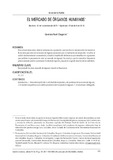| dc.creator | Chaparro, Germán Raúl; Universidad Nacional de Colombia | spa |
| dc.date.accessioned | 2017-03-14T12:52:03Z | |
| dc.date.available | 2017-03-14T12:52:03Z | |
| dc.date.created | 2016-08-03 | |
| dc.identifier | http://revistas.udem.edu.co/index.php/economico/article/view/1826 | spa |
| dc.identifier | 10.22395/seec.v19n39a5 | spa |
| dc.identifier.issn | 0120-6346 | |
| dc.identifier.uri | http://hdl.handle.net/11407/3092 | |
| dc.description | Este artículo tiene como objetivo presentar los argumentos que justifican la incorporación de incentivos financieros para resolver la escasez de órganos necesarios para la realización de trasplantes. Se utiliza el análisis microeconómico convencional y al análisis simplificado del bienestar para identificar los argumentos que justifican la propuesta de crear un mercado de órganos. Se concluye que los incentivos financieros potencialmente podrían incrementar la oferta de órganos y ampliar el rango de elección de los individuos. | spa |
| dc.description.abstract | The main objective of this article is to present arguments that justify the incorporation of financial incentives for solving the scarcity of organs needed for transplants. In order to identify the arguments that justify the organ market proposal, a conventional microeconomics analysis and the simplified wellbeing analysis are used. It is concluded that the financial incentives could potentially increase the supply of organs and amplify the range of options for individuals. | eng |
| dc.format.extent | p.113-130 | spa |
| dc.format.medium | Electrónico | spa |
| dc.format.mimetype | application/pdf | |
| dc.format.mimetype | PDF | |
| dc.language.iso | spa | |
| dc.publisher | Universidad de Medellín | spa |
| dc.publisher | Universidad de Medellín | spa |
| dc.relation | http://revistas.udem.edu.co/index.php/economico/article/view/1826/1694 | spa |
| dc.relation.ispartofseries | Semestre Económico; Vol. 19, núm. 39 (2016) | spa |
| dc.relation.haspart | Semestre Económico; Vol. 19, núm. 39 - enero/junio 2016 | spa |
| dc.rights.uri | http://creativecommons.org/licenses/by-nc-sa/4.0/ | * |
| dc.source | Semestre Económico Universidad de Medellín; Vol. 19, núm. 39 (2016); 113-130 | spa |
| dc.source | 2248-4345 | spa |
| dc.source | 0120-6346 | spa |
| dc.subject | Health economics | spa |
| dc.subject | organs market | spa |
| dc.subject | financial incentives | spa |
| dc.subject | Economía de la salud | spa |
| dc.subject | mercado de órganos | spa |
| dc.subject | incentivos financieros | spa |
| dc.subject | Economia da saúde | spa |
| dc.subject | mercado de órgãos | spa |
| dc.subject | incentivos financeiros | spa |
| dc.title | El mercado de órganos humanos | spa |
| dc.type | artículo de revisión | eng |
| dc.type | Review article | eng |
| dc.type | Artigo de revisão | eng |
| dc.rights.accessrights | info:eu-repo/semantics/openAccess | |
| dc.identifier.doi | http://dx.doi.org/10.22395/seec.v19n39a5 | |
| dc.relation.citationvolume | 19 | |
| dc.relation.citationissue | 39 | |
| dc.relation.citationstartpage | 113 | |
| dc.relation.citationendpage | 130 | |
| dc.audience | Comunidad Universidad de Medellín | spa |
| dc.publisher.faculty | Facultad de Ciencias Económicas y Administrativas | spa |
| dc.coverage | Lat: 06 15 00 N degrees minutes Lat: 6.2500 decimal degreesLong: 075 36 00 W degrees minutes Long: -75.6000 decimal degrees | spa |
| dc.publisher.place | Medellín | spa |
| dc.description.resumo | Este artigo tem como objetivo apresentar os argumentos que justificam a incorporação de incentivos financeiros para resolver a escassez de órgãos necessários para a realização de transplantes. Se utiliza aanálise microeconómico convencional e a análise simplificada do bem-estar para identificar os argumentos que justificam a proposta de criar um mercado de órgãos. Se conclui que os incentivos financeiros potencialmente poderiam incrementar a oferta de órgãos e ampliar o faixa de eleição dos indivíduos | por |
| dc.relation.ispartofes | Semestre Económico | spa |
| dc.title.alternativepor | O mercado de órgãos humanos | por |
| dc.title.alternativeen | Human organs market | eng |
| dc.relation.references | Arrow, Kenneth (1963). Uncertainty and the Welfare Economics of Medical Care. En: The American Economic Review, Vol. 53, N° 5, diciembre, pp. 941-973. | spa |
| dc.relation.references | Barnett, Andrew H.; Blair, Roger D. y Kaserrman, David. L. (1992). Improving Organ Donation: Compensation Versus Markets. En: Inquiry, Vol. 29, N° 3, pp. 372-378. | spa |
| dc.relation.references | Barney, L. Dwayne, y Reynolds, R. Larry (1989). An economic analysis of transplant organs. En: Atlantic Economic Journal, Vol. 17, N° 3, septiembre, pp. 11-20. | spa |
| dc.relation.references | Barney, L. Dwayne, y Reynolds, R. Larry. (1991). An economic analysis of transplant organs: Reply. En: Atlantic Economic Journal, Vol. 19, N° 2, junio, p. 64-65. | spa |
| dc.relation.references | Becker, Gary Stanley (1976). Altruism, Egoism, and Genetic Fitness: Economics and Sociobiology. En: Journal of Economic Literature, Vol. 14, N° 3, septiembre, pp. 817-826. | spa |
| dc.relation.references | Becker, Gary Stanley (1981). Altruism in the Family and Selfishness in the Market Place. En: Económica, Vol. 48, N° 189, pp. 1-15. | spa |
| dc.relation.references | Becker, Gary Stanley (1987). Tratado sobre la Familia. Madrid, Alianza Editorial, 366p. | spa |
| dc.relation.references | Becker, Gary Stanley (1997). How Uncle Sam Could Ease the Organ Shortage. En: Business Week, N° 3510, 20 de enero, p. 10. | spa |
| dc.relation.references | Becker, Gary Stanley (2003). Aspects on the Economics of Organ Transplantation. En: Transplantation Proceedings, Vol. 35, N.° 3, p. 897. | spa |
| dc.relation.references | Becker, Gary Stanley y Elías, Julio Jorge (2007). Introducing Incentives in the Market for Live and Cadaveric Organ Donations. En: Journal of Economic Perspectives, Vol. 21, N° 3, pp. 33-24. | spa |
| dc.relation.references | Becker, Gary Stanley y Elias, Julio Jorge (2014). Cash for Kidneys:The Case for a Market for Organs. En: The Wall Street Journal. 18 de enero de 2014. | spa |
| dc.relation.references | Browning, E. K., y Zupan, M. A. (2006). Microeconomic Theory and Applications. Nueva York, Wiley, 624p. | spa |
| dc.relation.references | Cohen, Lloyd R. (1989). Increasing the Supply of Transplant Organs: The Virtues of a Futures Market. En: George Washington Law Review, Vol. 58, N.° 1, pp. 1–51. | spa |
| dc.relation.references | Gale, David (1955). The Law of Supply and Demand. En: Mathematica Scandinavica, Vol. 3, pp.155-169. | spa |
| dc.relation.references | Gill, M. B. y Sade, R. M. (2002). Paying for Kidneys: The Case against Prohibition. En: Kennedy Institute of Ethics Journal, Vol. 12, N° 1, pp. 17-45. | spa |
| dc.relation.references | IRODAT (2016), Database. International Registry in Organ Donation and Transplantation. Barcelona. | spa |
| dc.relation.references | Kaserman, David L. y Barnett, A. H. (2002). The U. S. Organ Procurement System: A Prescription for Reform. Washington, D. C., American Enterprise Institute for Public Policy Research, 177p. | spa |
| dc.relation.references | Kaserman, David L., y Barnett, A. H. (1991). An Economic Analysis of Transplant Organs: A Comment and Extension. En: Atlantic Economic Journal, Vol. 19, N° 2, junio, pp. 57-63. | spa |
| dc.relation.references | Machnicki, G., Seriai, L., y Schnitzler, M. A. (2006). Economics of transplantation: a review of the literature. En: Transplantation Reviews, Vol. 20, N° 2, abril, pp. 61-75. | spa |
| dc.relation.references | Marshall, Alfred (1897). The Old generation of Economist and the New. En: Quarterly Journal of Economics, Vol. 11, N° 2, enero, pp. 115-135. | spa |
| dc.relation.references | Matas, Arthur J. (2004). The Case for Living Kidney Sales: Rationale, Objections and Concerns. En: American Journal of Transplantation, Vol. 4, pp. 2007-2017. | spa |
| dc.relation.references | Matas, A. J., y Schnitzler, M. (2003). Payment for Living Donor (Vendor) Kidneys: A Cost-Effectiveness Analysis. En: American Journal of Transplantation 2003, Vol. 4, N° 2, febrero, pp. 216-221. | spa |
| dc.relation.references | Matas, A. J., Schnitzler, M., y Daar, A. S. (2004). Payment for Living Donor (Vendor) is Not an Abstract Ethical Discussion Occurring in a Vacuum. En: American Journal of Transplantation,Vol. 4, N° 8, agosto, pp. 1380-1381. | spa |
| dc.relation.references | Mandeville, Bernard (1982). La fábula de las abejas: los vicios privados hacen la prosperidad pública. México, D. F., Fondo de Cultura Económica. | spa |
| dc.relation.references | OPTN (2016). OPTN Database. Organ Procurement and Transplantation Network and the Scientific Registry of Transplant Recipients. Ann Arbor. | spa |
| dc.relation.references | OPTN/SRTR (2014). OPTN/SRTR Annual Data Report 2014. En: American Journal of Transplantation, Vol. 16, N° suplemento S2, pp. 4-215. | spa |
| dc.relation.references | Pindyck, Robert y Rubinfeld, Daniel (1995). Microeconomía. Madrid: Prentice-Hall. | spa |
| dc.relation.references | Radclffe-Richards, J., Daar, A. S., Guttman, R. D., Hoffenberg, R., Kennedy, I., Lock, M. y Tilney, N.(1998). The Case for Alowing Kidney Sales. En: The Lancet, Vol. 351, N° 9120, pp. 1950-1952. | spa |
| dc.relation.references | Rothman, D.J., E. Rose, T. Awaya, B. Cohen, A. Daar, S.L. Dzemeshkevich, C.J. Lee, R. Munro, H. Reyes, S.M. Rothman, K.F. Schoen, N. Scheper-Hughes, Z. Shapira y H. Smit. (1997).Informe del Grupo Especial, Reunido en Bellagio, Sobre Trasplante, Integridad Corporal y Tráfico Internacional de Órganos. En: Transplantation Proceedings, N° 29, pp. 2739-2745. | spa |
| dc.relation.references | Schnitzler, M. A., Whiting, J. F., Brennan, D. C., Lentine, K. L., Desai, N. M., Chapman, W., Abbott, K. C. y Kalo, Z. (2005). The Life-Years Saved by a Deceased Organ Donor. En: American Journal of Transplantation, Vol. 5, N° 9, pp. 2289-2296. | spa |
| dc.relation.references | Smith, Adam (1776). Investigación sobre la naturaleza y las causas de la riqueza de las naciones. México, D. F., Fondo de Cultura Económica, 917p. | spa |
| dc.relation.references | Tullock, Gordon y McKenzie, Richard (1978). La nueva frontera de la economía. Madrid: Espasa--Calpe, 368p. | spa |
| dc.relation.references | USRDS (2015). 2015 USRDS Annual Data Report: Volume 2: End-Stage Renal Disease in the United States. United States Renal Data System, 390p. | spa |
| dc.identifier.eissn | 2248-4345 | |
| dc.type.version | info:eu-repo/semantics/publishedVersion | |
| dc.type.driver | info:eu-repo/semantics/article | |
| dc.identifier.reponame | reponame:Repositorio Institucional Universidad de Medellín | spa |
| dc.identifier.instname | instname:Universidad de Medellín | spa |



